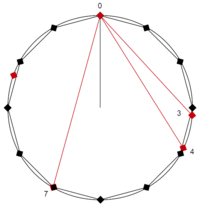
The β (beta) scale is a non-octave-repeating musical scale invented by Wendy Carlos and first used on her album Beauty in the Beast (1986). It is derived from approximating just intervals using multiples of a single interval without, as is standard in equal temperaments, requiring an octave (2:1). It may be approximated by splitting the perfect fifth (3:2) into eleven equal parts [(3:2)1⁄11 ≈ 63.8 cents]. It may be approximated by splitting the perfect fourth (4:3) into two equal parts [(4:3)1⁄2],[1] or eight equal parts [(4:3)1⁄8 = 64 cents],[2] totaling approximately 18.8 steps per octave.
The scale step may also precisely be derived from using 11:6 (B↑♭-, 1049.36 cents, ) to approximate the interval 3:2⁄5:4,[3] which equals 6:5 .
In order to make the approximation as good as possible we minimize the mean square deviation. ... We choose a value of the scale degree so that eleven of them approximate a 3:2 perfect fifth, six of them approximate a 5:4 major third, and five of them approximate a 6:5 minor third.[3]
and ()
Although neither has an octave, one advantage to the beta scale over the alpha scale is that 15 steps, 957.494 cents, is a reasonable approximation to the seventh harmonic (7:4, 968.826 cents)[3][4] though both have nice triads[1] (, , and ). "According to Carlos, beta has almost the same properties as the alpha scale, except that the sevenths are slightly more in tune."[1]
The delta scale may be regarded as the beta scale's reciprocal since it is "as far 'down' the (0 3 6 9) circle from α as β is 'up'."[5]
| interval name | size (steps) |
size (cents) |
just ratio | just (cents) |
error |
| major second | 3 | 191.50 | 9:8 | 203.91 | −12.41 |
| minor third | 5 | 319.16 | 6:5 | 315.64 | +3.52 |
| major third | 6 | 383.00 | 5:4 | 386.31 | −3.32 |
| perfect fifth | 11 | 702.16 | 3:2 | 701.96 | +0.21 |
| harmonic seventh | 15 | 957.49 | 7:4 | 968.83 | −11.33 |
| octave | 18 | 1148.99 | 2:1 | 1200.00 | −51.01 |
| octave | 19 | 1212.83 | 2:1 | 1200.00 | +12.83 |
- ^ a b c Milano, Dominic (November 1986). "A Many-Colored Jungle of Exotic Tunings", Keyboard.
- ^ Carlos, Wendy (2000/1986). "Liner notes", Beauty in the Beast. ESD 81552.
- ^ a b c Benson, Dave (2006). Music: A Mathematical Offering, p.232-233. ISBN 0-521-85387-7. "Carlos has 18.809 β-scale degrees to the octave, corresponding to a scale degree of 63.8 cents."
- ^ Sethares, William (2004). Tuning, Timbre, Spectrum, Scale, p.60. ISBN 1-85233-797-4. Scale step of 63.8 cents.
- ^ Taruskin, Richard (1996). Stravinsky and the Russian Traditions: A Biography of the Works through Mavra, p.1394. ISBN 0-520-07099-2.



